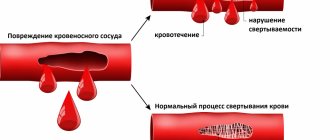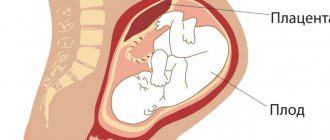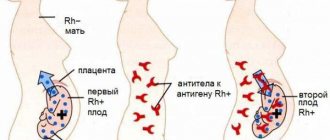Detailed description of the study
Von Willebrand factor (VWF) is a large protein that is a blood clotting factor and is involved in stopping bleeding. It ensures the formation of a clot of platelets at the site of vessel damage and protects factor VIII, an antihemophilic plasma protein, from destruction.
The hemostatic system is a combination of mechanisms that are responsible for stopping bleeding when a vessel is damaged. First, a primary clot is formed due to the action of platelets and the walls of the vessel itself. Next, plasma proteins participate in the formation of a dense blood clot, which finally eliminates the defect. Von Willebrand factor, unlike other clotting factors, is directly involved in the formation of a blood clot.
Von Willebrand factor is synthesized in the bone marrow. In addition, it is produced by cells lining the inner surface of blood vessels (endothelium). The protein is able to bind to factor VIII, and if a vessel is damaged, it delivers it to the site of vessel damage for effective blood clotting. Also, von Willebrand factor binds to a protein on the surface of platelets, which activates their gluing to each other (adhesion). Another of its functions is the attachment of platelets to collagen, which is released when the integrity of the vascular wall is violated. All of these processes ultimately lead to successful stopping of bleeding and restoration of the integrity of the blood vessel.
A defect in the gene that responds to the production of von Willebrand factor leads to the development of hereditary coagulopathy - von Willebrand disease. There are three types of the disease. The first type is the most common. At the same time, the amount of VWF in the blood is moderately reduced and functions are not impaired. The second type is when the functional activity of VWF is impaired, even with sufficient levels in the blood. The third type is severe, observed quite rarely, the amount of EF is sharply reduced.
Clinically, the disease manifests itself as prolonged bleeding of various locations: from the nose, gums, gastrointestinal tract, uterus. The disease is characterized by the appearance of bruises that do not correspond to the size of the injury. Bleeding is also observed after small cuts that do not stop for a long time; bleeding time increases after operations and dental procedures, such as tooth extraction.
In severe forms of von Willebrand disease (often type 3), symptoms similar to hemophilia may occur due to factor VIII deficiency. Muscle hematomas and hemarthrosis appear - hemorrhages into the joint cavity. The consequences of the disease are cerebral hemorrhages, bleeding from internal organs, decreased hemoglobin in the blood (anemia).
Determining the amount of von Willebrand factor in the blood is necessary to assess the state of the coagulation system and timely diagnosis of von Willebrand disease, which leads to bleeding.
2.Types of disease depending on the severity of the disease
The severity of the disease is classified by type:
- 1 type
The most common and easiest form. The decrease in blood clotting is insignificant. The patient may not be aware of the presence of the syndrome. Von Willebrand-Jurgens factor is present in the blood, but in insufficient concentration. - Type 2
There is von Willebrand-Jurgens factor in the blood, but it does not work. The form is rarer, but also more dangerous. It is inherited in some cases - with a certain combination of genetic characteristics of the parents. It manifests itself as minor bleeding without visible prerequisites. - Type 3
Only 5% of patients have von Willebrand-Jurgens factor completely absent. Serious risk of bleeding, anemia and complications during operations.
Most often, von Willebrand-Jurgens syndrome is a congenital pathology. The disease is acquired against the background of some other conditions and disorders.
Since von Willebrand-Jurgens syndrome is based on a clotting disorder, blood can appear where bleeding should not occur in a healthy person. The most commonly observed:
- nosebleeds;
- menstrual bleeding in women;
- blood in urine;
- subcutaneous hematomas;
- bleeding of the oral mucosa;
- dark stools (stained with blood);
- joint hemorrhages as a result of movement.
Even with type 1 of the disease, the patient, when visiting any doctor, must inform him of his diagnosis
, since many manipulations, studies and procedures involve microtraumas that are not dangerous for healthy people. The patient's condition must be taken into account when prescribing and choosing a particular treatment regimen for him.
Visit our Therapy page
References
- Zozulya, N.I., Kumskova, M.A., Likhacheva, E.A. and others. Clinical guidelines for the diagnosis and treatment of von Willebrand disease. — Congress of Hematologists of Russia, 2022. — 30 p.
- Chernova E.V. von Willebrand factor. — Bulletin of the North-Western State Medical University named after. I.I. Mechnikova, 2018. - T. 10. - No. 4. - P. 73–80.
- Chubukov, Zh.A. Von Willerbrand factor and endothelial dysfunction under stress. - Problems of health and ecology, 2012. - pp. 40-44.
- Pathophysiology: textbook: in 2 volumes / ed. V.V. Novitsky, E.D. Goldberg, O.I. Urazova. — 4th ed., revised. and additional - GEOTAR-Media, 2009. - T. 2. - 640 p.
4. Treatment of von Willebrand-Jurgens syndrome
Specific treatment
this disease does not exist. Medical care is usually aimed at stopping bleeding that occurs. If surgical treatment is necessary, measures are taken to prevent bleeding (plasma preparations with a high content of von Willebrand factor, desmopressin, aminocaproic acid are used). In cases of severe forms of the disease, when there is a high risk of bleeding even from household injuries and bruises, medications are prescribed that prevent the destruction of blood clots after they form. As an emergency, fibrin glue or prombin powder is used to help stop bleeding from the wound.
Patients should
know and avoid taking medications whose side effect is a decrease in blood clotting (heparin, aspirin, ibuprofen, naproxen, medications containing salicylates). Patients with severe forms should be able to inject themselves with clotting factors. It is also necessary to know and identify the signs of hidden bleeding. To reduce household injuries, you need to monitor your weight, maintain good physical shape, while avoiding dangerous sports.
Links[edit]
- ^ abc GRCh38: Ensembl Issue 89: ENSG00000110799 - Ensembl May 2022
- ^ abc GRCm38: Ensembl release 89: ENSMUSG00000001930 - Ensembl, May 2022
- "Human PubMed Reference:". National Center for Biotechnology Information, US National Library of Medicine
. - "Mouse PubMed link:". National Center for Biotechnology Information, US National Library of Medicine
. - ^ B s d e g h i Sadler JE (1998). "Biochemistry and genetics of von Willebrand factor". Annual Review of Biochemistry
.
67
: 395–424. DOI: 10.1146/annurev.biochem.67.1.395. PMID 9759493. - Shahidi, M (2017). "Thrombosis and von Willebrand factor". Adv Exp Med Biol
.
Advances in experimental medicine and biology. 906
:285–306. DOI: 10.1007/5584_2016_122. ISBN 978-3-319-22107-6. PMID 27628010. - ^ a b Zhou Y.F., Eng E.T., Zhu J., Lu K., Waltz T., Springer T.A. (July 12, 2012). "Sequence and structure of relationships within von Willebrand factor". Blood
.
120
(2):449–58. DOI: 10.1182/blood-2012-01-405134. PMC 3398765. PMID 22490677. - Jakobi AJ, Mashaghi A, Tans SJ, Huizinga EG. Calcium modulates force perception by the von Willebrand factor A2 domain. Blood. 2011 April 28, 117: 17 Nature Commun. July 12, 2011; 2: 385. [1]
- Luken BM, Winn LY, Emsley J, Lane DA, Crowley JT (June 2010). "Importance of vicinal cysteines, C1669 and C1670, for von Willebrand factor A2 domain function". Blood
.
115
(23):4910–3. DOI: 10.1182/blood-2009-12-257949. PMC 2890177. PMID 20354169. - ^ ab Lenting PJ, Christophe OD, Denis CV (March 2015). "Von Willebrand factor biosynthesis, secretion and clearance: connecting the far ends". Blood
.
125
(13):2019–28. DOI: 10.1182/blood 2014-06-528406. PMID 25712991. S2CID 27785232. - ↑
Randi AM, Laffan MA (January 2022).
"Von Willebrand Factor and Angiogenesis: Basic and Applied Issues" (PDF). Journal of Thrombosis and Hemostasis
.
15
(1): 13–20. DOI: 10.1111/jth.13551. hdl: 10044/1/42796. PMID 27778439. S2CID 3490036. - ↑
Levy G.G., Motto D.G., Ginzburg D. (July 2005).
“ADAMC13 turns 3 years old.” Blood
.
106
(1):11–7. DOI: 10.1182/blood-2004-10-4097. PMID 15774620. - Sadler JE, Budde U, Eikenboom JC, Favaloro EY, Hill F, Holmberg L, Ingerslev J, Lee SA, Lillicrap D, Mannucci PM, Mazurier S, Meyer D, Nichols WL, Nishino M, Pique IK, Rodeghiero F, Schneppenheim R, Ruggeri ZM, Srivastava A, Montgomery RR, Federici AB. (October 2006). "Update on the pathophysiology and classification of von Willebrand disease: report of the Von Willebrand Factor Subcommittee". Journal of Thrombosis and Hemostasis
.
4
(10): 2103–14. DOI: 10.1111/j.1538-7836.2006.02146.x. PMID 16889557. - ↑
Vincentelli A, Susen S, Le Tourneau T, Six I, Fabre O, Juthier F, Bauters A, Decoene C, Goudemand J, Prat A, Jude B (July 2003).
"Acquired von Willebrand syndrome in aortic stenosis". New England Journal of Medicine
.
349
(4):343–9. DOI: 10.1056/NEJMoa022831. PMID 12878741. S2CID 24314893. - Moake JL (January 2004). "Von Willebrand factor, ADAMTS-13 and thrombotic thrombocytopenic purpura". Seminars on hematology
.
41
(1): 4–14. DOI: 10.1053/j.seminhematol.2003.10.003. PMID 14727254. - Denorme, F (2016). "The VWF-GPIb axis in ischemic stroke: lessons from animal models". Thrombosis and hemostasis
.
116
(4):597–604. DOI: 10.1160/TH16-01-0036. PMID 27029413. - Roldan V, Marín R, Muiña V, Torregroce YM, Hernandez-Romero D, Valdez M, Vicente V, Guba GY (June 2011). "Plasma von Willebrand factor levels are an independent risk factor for adverse events including mortality and major bleeding in patients with atrial fibrillation receiving anticoagulants". Journal of the American College of Cardiology
.
57
(25):2496–504. DOI: 10.1016/j.jacc.2010.12.033. PMID 21497043. - von Willebrand E. A. (1926). "Hereditary pseudohemophilia". Fin Läkaresällsk Handl
(in Swedish).
68
: 87–112. Reproduced in Von Willebrand EA (May 1999).
"Hereditary pseudohemophilia". Hemophilia
.
5
(3): 223-31, discussion 222. DOI: 10.1046/j.1365-2516.1999.00302.x. PMID 10444294. S2CID 221750622. - Weiss, Harvey J.; Hoyer, Leon W. (December 14, 1973). "Von Willebrand factor: dissociation from the procoagulant activity of antihemophilic factor". The science
.
182
(4117):1149–1151. Bibcode: 1973Sci...182.1149W. DOI: 10.1126/science.182.4117.1149. PMID 4127287. S2CID 41340436. - Weiss, H.J.; Rogers, J; Brand, H (1973). "Defective platelet aggregation induced by ristocetin in von Willebrand disease and its correction by factor VIII". Journal of Clinical Research
.
52
(11):2697–707. DOI: 10.1172/JCI107464. PMC 302536. PMID 4201262. - Pareti FI, Fujimura Y, Dent JA, Holland LZ, Zimmerman TS, Ruggeri ZM (November 1986). "Isolation and characterization of the collagen binding domain in human von Willebrand factor". Journal of Biological Chemistry
.
261
(32):15310–5. PMID 3490481. - Heydari M, Mehrbod M, Ejtehadi MR, Mofrad MR (August 2015). "Cooperation with von Willebrand factors enhances the adsorption mechanism". Journal of the Royal Society, Interface
.
12
(109): 20150334. DOI: 10.1098/rsif.2015.0334. PMC 4535404. PMID 26179989.
Diagnostics
Diagnosis of von Willebrand disease requires the indispensable participation of hematologists. It is impossible to make a diagnosis at the level of a clinic or children's consultation due to the lack of capabilities of the laboratories of these institutions to conduct specific diagnostic tests and enzyme-linked immunosorbent technologies. The doctor assumes the disease when interviewing relatives, examining the patient and taking into account information from the anamnesis.
Moreover, available tests vary in sensitivity and diagnostic value. Therefore, an algorithm for examining the suspected patient has been developed.
- First, a coagulogram is studied with all indicators of coagulation, including bleeding time. The test can be done at your clinic. If pathological abnormalities are detected, the patient is referred to the hematology center.
- To identify a specific type of disease and the qualitative side of the defect, a comparison of the impaired aggregation ability under the influence of ristocetin with the normal one is used - under the influence of collagen, thrombin, ADP, and adrenaline.
- The main method of detecting a decrease in the amount of factor VIII in the blood is to determine the activity of the patient’s platelets treated with formaldehyde in reaction with a solution of ristocetin.
- Using the collagen-binding technique, the impaired functional ability of factor VIII and the specific type of disease are identified.
In the diagnosis of concomitant lesions of the mucous membranes it is necessary:
- examination by an otolaryngologist;
- esophagogastroduodenoscopic examination;
- colonoscopy (examination of the intestines).
For treatment, it is important to identify vascular formations in the form of tortuosity, angiomas, extensions up to 2 mm, which contribute to bleeding.
Symptoms
The symptoms of von Willebrand disease are extremely diverse: from minor episodic bleeding to massive, debilitating bleeding, leading to severe blood loss.
Signs characteristic of von Willebrand disease:
- severe, prolonged or spontaneously renewing bleeding after minor surgical interventions, tooth extraction;
- subcutaneous hematomas that appear after minor traumatic impacts or spontaneously
- bleeding for more than 15 minutes after minor injuries or spontaneously recurrent bleeding 7 days or more after injury;
- hemorrhagic skin rash;
- severe anemia;
- intense, prolonged menstruation;
- spontaneous nosebleeds lasting more than 10 minutes or requiring medical intervention due to the intensity;
- blood in feces in the absence of gastrointestinal pathology that can provoke the development of gastrointestinal bleeding.
More often, increased bleeding is observed in childhood, decreasing as they grow older, and subsequently there is an alternation of exacerbations and remissions.







